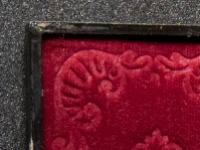Out of some 600 items in HSP’s collection of cased photographs, the very first one I opened was an absolute gem. My work lets me examine and admire many old photographs, but never before had I encountered one with its own accompanying love letter which brought the photograph to life.
When I first opened the lovely, small, shiny floral case I found inside, before I even saw the enclosed image, a small paper package, folded carefully to fit within the little 2 3/8 x 2 7/8” case. With care I unfolded the paper and read the following:
|
|
7th day ever
Dear Robert
It is with pleasure I give thee this small token of love. I give it with the hope that thee may like it and treasure it for the givers sake. If it is not as thee would like it allow me to change it. Oh! my dear one how I would love to be with thee tonight - no language of mine can tell of the depths of my heart, my affections are unlimited toward those I turn them and thee dearest is that loved object. (illeg.) trust in me believe me to be there - I stood on the verandah a long time this eve as the darkness gathered round me alone in person. but in sentiment thee and the loved thee is with were near me - May this picture speak of comfort to thy lone heart, may it breathe of fond and deep affection and whisper prayers for thy future happiness. all these would the original do if in her power then to thy imagination let this trifle speak of me. All are strangers to me here. I stand apart and think of thee, and think of thee. Thee will never know my heart thee cannot know my deep affection except by measuring it by the same balance with thy own. I am in haste so my darling one Good night. good night. Thy Fanny
|
By the time I had finished the transcription I was smitten!
Not only did I have the name of the woman depicted in the photograph—Fanny—I had in front of me a letter, written to her sweetheart in her own delicate, cursive penmanship over 150 years ago.
And what a letter!
Although I am a passionate admirer of all things photographic, I am by no means any less enthralled by the romantic nature of this love letter. But what I found particularly striking was the way Fanny’s letter put into words the value such an object—a photograph—held in the mid 1850s, when photography was still only in its youth. Fanny writes, “May this picture speak” and “may it breathe” as though, to her, the photograph was so vibrant and life-like that it had a voice and breath all its own, to carry across a great distance the sender’s fondest affections and prayers. Such was the value of these early photographs in a time, long before internet, or even telephones were invented, when travel meant great distances and time separated loved ones.
The fact that these fragile images—on breakable glass or easily scratched emulsions—created a need for a whole industry of case-making designed to house and protect them speaks volumes to how cherished these early photographs were to those who commissioned a photographer’s services, and to those who became the lucky recipients of the final product.
I have read, in my study of photographic history, many tracts written by practitioners of the photographic arts, expounding upon the wonders and inherent value of the photograph. But never, before this, have I seen such an eloquently written piece that so succinctly, and from the heart, expresses the social value of the photograph in its earliest days.
As a happy end-note, I am thrilled to report that soon after I discovered the full identities of Fanny and her Robert when I found two more cased photographs of Fanny, as well as two cased photographs of her sweetheart Robert in HSP’s cased photographs collection. Apparently they were married on June 24, 1858, and obviously the photographs remained cherished items as they were donated to HSP by Fanny and Robert’s daughter Anne in 1931, some 73 years after they were first taken.
|
|
|
|
HSP's cased photographs collection (Collection 3139) is now accessible on HSP's website.







![5617-3139_b2Af113_1 Image: 1/6 plate; Head and shoulders of a man wearing a jacket with a high collar, a vest, tie, and upturned collar, with color applied to the cheeks. Preserver: [none]. Mat: Oval with sandy finish (late 1840s). Case: Paper-covered wood-frame embossed with a floral design on the front, and geometric design on the back, with red velvet pinchpad, and red velvet cushion embossed with floral pattern and Gallery name and address.](/sites/default/files/images/5617-3139_b2af113_11.jpg)
